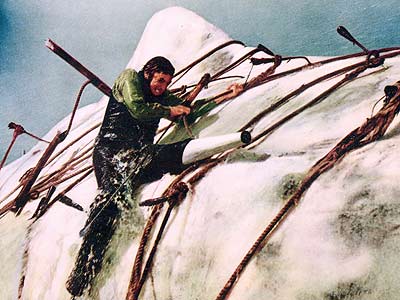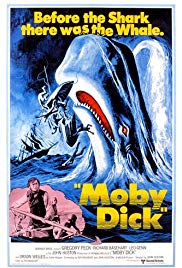MOBY DICK
SUBJECTS — Literature/U.S.; Seafaring; U.S./1812 – 1860; Massachusetts;
SOCIAL-EMOTIONAL LEARNING — Revenge; Humility;
MORAL-ETHICAL EMPHASIS — Responsibility.
AGE: 10+; No MPAA Rating;
Drama; 1956; 116 minutes; Color.
MENU
DESCRIPTION
It is the early 1800s. Ahab, the captain of a whaling ship out of New Bedford, is obsessed with killing a great albino sperm whale. Ahab had lost a leg in his last encounter with the White Whale and he’s looking for revenge. Ahab motivates his crew with promises of money to the first man who sights the whale. When they hear reports of the White Whale, the Captain orders the ship to sail after it. All thought of whaling as a commercial enterprise is forgotten. When they sight the White Whale … if you don’t know the story yet we won’t spoil it for you.
This movie is based on the novel by Herman Melville, one of the great works of American Literature.
SELECTED AWARDS & CAST
Selected Awards: 1956 National Board of Review Awards: Ten Best Films of the Year, Best Director (Huston).
Featured Actors: Gregory Peck, Richard Basehard, Orson Welles, Leo Genn, Harry Andrews, Friedrick Ledebur.
Director: John Huston.
BENEFITS OF THE MOVIE
“Moby Dick” will give children a good idea of what life was like on a whaling ship in the early 1800s. It is full of biblical references.
POSSIBLE PROBLEMS
MINOR. When Queequeg thinks that he is going to die and goes into a trance, the other sailers cut his skin with a knife to see if he will react.
PARENTING POINTS
Before you show the film, tell children the stories of Jonah and the whale, and the prophet Elijah’s conflict with King Ahab. (See the Helpful Background section). Then ask and help your child to answer the Quick Discussion Question.
HELPFUL BACKGROUND

Much of the Old Testament describes the work of the prophets, men who had a special relationship with God and who preached the word of God. Prophets also predicted the future, especially when the Israelites had strayed from the word of God. One of the great prophets of the Old Testament was Elijah, who was often in conflict with Ahab, a king of Israel. Ahab had been persuaded by Jezebel, his Canaanite wife, to reject the God of Israel and worship Baal, a Canaanite god. Israel suffered years of drought and famine that demonstrated the power of Jehovah and the impotence of Baal. Still Ahab would not repent and acknowledge Jehovah as God. Finally, Elijah pronounced God’s death sentence on Ahab.
Jonah was a prophet who had been instructed by God to go to the gentile city of Ninevah to preach the word of God and to cry out against its sins. But Jonah was unwilling to go. He took a ship bound for another city to flee from the presence of God. A great storm arose and the ship was in danger. This was obviously no normal storm and the sailors cast lots to ascertain on whose account the storm had been sent. The lot fell to Jonah who confessed that he was a worshipper of God and that he had disobeyed God. He told the sailors to cast him into the water and the storm would end. They reluctantly agreed, the prophet disappeared into the waters, and the sea became quiet. But Jonah didn’t drown. He was immediately swallowed by a great fish sent by God. Amazed to be alive and grateful for God’s mercy, Jonah repented his disobedience and after several days the fish vomited him up onto the land. Asked by God to go to Ninevah a second time, Jonah obeyed. The gentiles in Ninevah repented their evil ways and God spared the city.
Captain Ahab has turned away from his true vocation, that of killing whales for oil and other products. Like King Ahab in the Bible, he is seduced by a false god, in this case the god of vengeance. His disobedience causes him, like Jonah, to be swallowed by the supernatural fish. But whereas Jonah always acknowledged God, Ahab does not, and he is not forgiven. The fish does not vomit him out. Instead, Ahab dies and takes all who he had led astray with him, except for one man who is left to tell the tale.
Whales are mammals: they breath air; they are warm-blooded, they give birth to live young, and they suckle their babies. Their bodies are hairless and streamlined for fast swimming. They have a large layer of fat which also streamlines their bodies and keeps them warm in cold ocean water.
Moby Dick is the whaler’s nightmare. Thousands upon thousands of these giant animals have been killed without turning on the boats, the ships and the sailors who were attacking them. What if one of these gigantic and powerful animals turned on his puny pursuers in their little row boats? What if he tried to attack the ship itself? Melville used these fears in his novel.
Saint Elmo’s Fire is a glow from electrical charges seen in stormy weather at the tip of a tall pointed object such as the mast of a ship. The negative electrical charge in the storm clouds induces a positive electrical charge on the mast.
When Queequeg was rolling bones, he was practicing “divination,” the art of telling the future or describing the unknown by occult means such as oracles, omens or signs. Examples of divination are: reading the lines on a person’s hand (palmistry, see For Whom the Bell Tolls ); interpreting the configuration of the stars and planets (astrology); analyzing the cries of birds and animals; the investigation of the entrails of dead animals (see Julius Caesar); interpreting cards dealt to a person from a special deck (tarot); and looking through crystal balls. Some form of divination has been practiced in all cultures. For example, palmistry is at least 4,000 years old and it is still popular today. In most cities, you can see the advertisements of palm readers. Astrology is also popular today and has been practiced for centuries.
DISCUSSION QUESTIONS
1. See Discussion Questions for Use With any Film that is a Work of Fiction.
2. A theme in this film is man’s relationship to nature. When viewed in this light, what does the White Whale represent? What does Ahab represent? What does this story tell us about the relationship between mankind and nature?
3. Why did Mr. Starbuck order the men to go after Moby Dick after Captain Ahab died?
4. How was Captain Ahab like the biblical King Ahab? What was the false god that Captain Ahab worshipped? What should he have done, rather than pursue the White Whale?
5. Compare the story of Moby Dick to the stories of Jonah and of King Ahab.
6. What brought Queequeg out of his trance?
SOCIAL-EMOTIONAL LEARNING
HUMILITY
1. One of the themes of this film is Ahab’s “hubris,” i.e., his belief that he could subdue an elemental force of nature embodied in the great White Whale. Define “hubris” and describe how that theme plays out in the film.
REVENGE
2. One of the themes of this film is Ahab’s unquenchable thirst for revenge and the effects of that desire on himself and his crew. Describe how revenge affects what happens to the characters in the movie.
3. Can a person take revenge upon an element of nature?
MORAL-ETHICAL EMPHASIS (CHARACTER COUNTS)
Discussion Questions Relating to Ethical Issues will facilitate the use of this film to teach ethical principles and critical viewing. Additional questions are set out below.
RESPONSIBILITY
(Do what you are supposed to do; Persevere: keep on trying!; Always do your best; Use self-control; Be self-disciplined; Think before you act — consider the consequences; Be accountable for your choices)
1. Describe which of the components of the Responsibility Pillar of ethical conduct was violated by Ahab and what the consequences were for him.
ASSIGNMENTS, PROJECTS & ACTIVITIES
BRIDGES TO READING
Books relating to whaling suitable for middle school and junior high readers include Whaling Days by Carol Carrick (biography) and Herman Melville by Rebecca Stefoff.
QUICK DISCUSSION QUESTION:
One of the themes of this film is Ahab’s “hubris,” i.e., his belief that he could subdue an elemental force of nature embodied in the great White Whale. Define “hubris” and describe how that theme plays out in the film.
Suggested Response:
“Hubris” means excessive pride or self-confidence that prevents us from seeing our proper relationship with forces larger than ourselves, such as God or nature. Another word for “hubris” is “arrogance.” In this story, Ahab believes that he can kill a whale who is renowned for sinking ships. He convinces the crew that they can do this as well. But there is at least one other layer to this. The white whale is a metaphor for the forces and bounty of nature. Ahab and the men stand for mankind. The effort to take the whale stands for the mindless pursuit of wealth through the exploitation of nature. Ahab’s “hubris” represents that of all mankind which attempts to overcome and destroy any force of nature in the mindless quest for riches and development. For examples, global warming may be the “White Whale” that wreaks nature’s vengeance upon us for our excessive use of fossil fuels.
BUILDING VOCABULARY:
harpoon, “Saint Elmo’s fire,” “to sound” [as in the whale has sounded], “to render” [as in rendering the whale’s fat], albino, trance.
Search Lesson Plans for Movies
Get our FREE Newsletter!
* we respect your privacy. no spam here!




